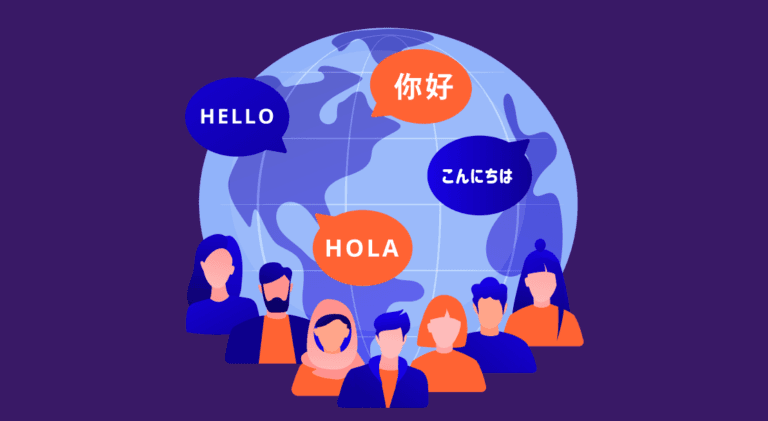What is Language Technology? Exploring its Benefits and Uses

Table of Contents
- What is Language Technology?
- Benefits of Using Technology in Language
- Uses of Language Tech
- Key Takeaways
- Conclusion
- FAQs
The last few years have seen a rapid advancement in technology, which has affected how we live and perceive the world around us. They have also enhanced our learning methods over time. Language is one of the significant fields of learning that has benefitted from the advent of technology and its development. Language technology is a fast-growing multi-disciplinary field of learning. Let’s understand what language technology is, its various aspects and numerous advantages.

What is Language Technology?
Language technology is a technological invention that has proved that machines are not limited to interpreting human languages. Language technology has grown and bolstered other areas like machine learning, linguistics, and information technology, and its applications are wide-reaching.
Translating words and sentences with the help of mobile software and applications is not a recent development. Neither is it very accurate as human languages are complex and include polysemantic words making it difficult for machines to accurately translate them into the goal language from the source language. But the invention of language tech makes it possible for our smart devices to accurately interpret the meaning of our words in another language and the proper context. Language tech makes it possible for machines to interpret the correct meaning of what a person speaks.
The crux of language technology focuses on the computational processing of human languages in spoken and written form. Language technology uses several applications like internet search engines, spoken language dialog systems, machine translation, etc. In the years to come, well-established natural language processing techniques and advanced methods will be required to mandatorily extract documents and text into excerpts with the meaning and context intact. Language tech is a promising research avenue in the near future and is fast-evolving.
Benefits of Using Technology in Language
Now that we know what language technology is, let’s look at its benefits. Language tech can enable humans to interact with robots without the help of an interface or medium like a computer that commands them in machine language. You can use spoken language tech to communicate with a robot without a computer keyboard, mouse, or even a remote control. One can also control devices using language tech; for example, lighting systems in smart homes can be switched on and off with a voice command.
Language tech is beneficial for the visually impaired. Visually impaired people constantly have to rely on text-to-speech dictation systems and screen readers, and converting audio to text is critical for hard-of-hearing individuals. Language tech can also be beneficial when one is involved in some other activity such as driving. Speech recognition systems involving language tech can make people’s everyday lives much easier.
Advancements in language tech have led to increased productivity and ease of use, especially in the realm of speech translation and language learning. Communication has become much faster with language tech, and key aspects of learning have improved immensely.
Uses of Language Tech
Since the RBMT (rule-based machine translation) and SMT (statistical machine translation) methods haven’t proven very successful, tech companies have started shifting towards natural language processing, also known as NLP.

NLP basically allows computers to understand text and the spoken language just like humans. It combines computational linguistics, machine learning, and deep learning. And all of this helps the AI understand the whole meaning of the language along with intent and even sentiment. NLP looks into the context of the words and helps localize the text better during translation. Though there are still issues with globalization in terms of policies, taxes, regulations, etc., in the information sector, there is for sure one realm that has been effectively mastered. And that is language technology.

Language tech and machine translation are two aspects of technology that have been perfected to the point where languages originating from the same family tree—for example, all the languages that have their origin in the Latin alphabet system, can be translated effortlessly and accurately.

Uses of Language Tech
Language tech has been around for some time and is here to stay. Built on natural language processing and artificial intelligence, language tech is a sphere of more than 40 years of research. Language technology can be effectively used in areas such as spoken language dialog systems, question answering systems, machine translation, and text summarization.
Spoken language dialog systems
Spoken language dialog systems enable a person to talk to a machine, like a computer. This is usually done via a device like a telephone. This action aims to enact some type of transaction or seek information. One of the applications of this is to talk to a machine and direct it to buy or sell stocks and shares. Getting route directions while driving is also a form of the spoken language dialog system.
Question answering systems
One can ask a device for information with the help of smart web-based systems. Using NLP techniques and natural language generation methods, the device can provide perfectly crafted answers.
Machine translation
A document in one language can easily be translated into another language with machine translation. Several applications and websites are available to help you translate documents and texts into the desired language as per your choice.
Text summarization
The purpose of text summarization tech is to produce shortened versions of long documents/ text for situations where there is an extreme shortage of time to read the entire original text. Text summarization is crucial in dealing with the issue of information overload. Photocopiers now can be instructed to reduce a 20-page document into less than five pages of its summarized version with the help of optical character recognition and language tech, combined in the form of text summarization.
Key Takeaways
- Language technology is one of the technological inventions that has proved that machines are not limited to interpreting human languages.
- Language technology focuses on the computational processing of human languages in spoken and written form.
- Language technology uses several applications like internet search engines, spoken languages dialog systems, machine translation, etc.
- Since the RBMT and SMT machine translation methods are not very successful, tech companies have started shifting towards natural language processing or NLP.
- Language tech and machine translation are two aspects of technology that have been perfected to the point where languages originating from the same family tree—for example, all the languages that have their origin in the Latin alphabet system—can be translated effortlessly and accurately.
- Language technology can be effectively used in areas such as spoken language dialog systems, question answering systems, machine translation, and text summarization.
- Spoken language dialog systems enable a person to talk to a machine, like a computer. Getting route directions while driving is also a form of the spoken language dialog system.
- A document in one language can easily be translated into another language with machine translation.
- The purpose of text summarization tech is to produce shortened versions of long documents/ text for situations where there is an extreme shortage of time to read the entire original text.
- Language tech can enable humans to interact with robots without the help of an interface or medium like a computer. One can also control devices using language tech, for example, lighting systems in smart homes that can be switched on and off with a voice command simply.
Conclusion
Now that you clearly understand what language technology is, it is high time that we all understand and realize that it is a key technology in the future years that will drive advances in computing in the coming years. It won’t be long before you can talk to your web search engine in any language and have it return the required text, link or document quickly, translated from another language into a language of your preference and choice. Industry activity in the field of language tech is on the rise. Major IT companies worldwide are focusing and centering their efforts to enhance further and develop language technology.

FAQs
NLP stands for natural language processing. It helps computers communicate with human beings in their own languages, and it can be used to scale other language-related tasks. With the help of NLP, computers can read text, hear speech, interpret it and even measure sentiment.
Email filters, also known as spam filters, are an example of the most basic application of natural language processing. Other examples of natural language processing are smart assistants, search results, language translation, predictive text, data analysis, digital phone calls, text analytics, etc.
Language tech is basically information tech specialized in dealing with complex information of a specific type. Thus it is also subsumed under the category of human language technology.
Technology can create and enhance a better learning experience for language learners. With technology in language learning, students are no longer just passive recipients; they have transformed into active participants. It allows a more profound and enhanced linguistic immersion for learners.
– Pronunciation tools
– Dictionary
– Translation tools
– Conversion tools
– Grammar tools
– Speaking tools
– Learning tools, etc.
MT or machine translation is the technology that automatically translates text by using terms and grammatical- syntactical analysis techniques.
Latest Blogs
Explore how Google’s 2025 AI search updates triggered ranking chaos. Learn actionable strategies to adapt your SEO for AI Overviews, zero-click searches, and SERP volatility. Stay ahead now.
Learn how to rank on AI search engines like ChatGPT, Perplexity, and Gemini by optimizing your content for authority, structure, and relevance. Stay ahead in AI-driven search with this strategic guide.
Explore the best healthcare SEO services for your medical practice. Improve online visibility and effectively reach more patients in need of your services.
Get your hands on the latest news!
Similar Posts

Language
6 mins read
A Guide on How to Do Language Translation

Language
5 mins read
A Complete Guide to Advertisement Translation

Language
6 mins read